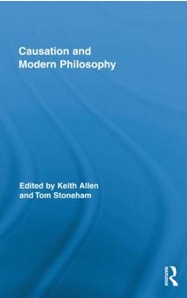
Papers
All papers are uncorrected drafts. Please refer to the final versions.
Comments welcome.
This paper considers two accounts of the way that colours are represented in perception, thought, and language that are consistent with relationalist theories of colour: Jonathan Cohen’s contextualist semantics for colour ascriptions, and Andy Egan’s suggestion that colour ascriptions have self-locating contents. I argue that colours are not represented in perception, thought, or language as mind-dependent relational properties, but as non-relational mind-independent properties.
There is an apparent tension between Locke’s definition of knowledge and his claim that we can know of the existence of things without the mind by sensation. In response to suggestions by Rickless and Newman, I argue that sensitive knowledge really is knowledge. Sensitive knowledge is consistent with Locke’s definition of knowledge once the role of ideas of reflection—and in particular, reflective awareness of receiving ideas from without—is recognised. Locke’s epistemological framework does lead not inevitably to scepticism, but the threat of idealism remains.
This paper presents an ‘over-representational’ account of blurred visual experiences. The basic idea is that blurred experiences provide too much, inconsistent, information about objects’ spatial boundaries, by representing them as simultaneously located at multiple locations. This account attempts to avoid problems with alternative accounts of blurred experience, according to which blur is a property of a visual field, a way of perceiving, a form of mis-representation, and a form of under-representation.
Forthcoming. ‘Ideas’, in the Oxford Handbook of British Philosophy in the Seventeenth Century, edited by Peter Anstey. Oxford: Oxford University Press.
This essay presents an overview of discussions of ideas in British seventeenth century philosophy, focussing on Hobbes, the Cambridge Platonists Cudworth and More, Locke, and Burthogge.
2011. ‘Revelation and the Nature of Colour’, dialectica, 65, pp. 153-176. The definitive version is available via Wiley-Blackwell.
According to naïve realist (or primitivist) theories of colour, colours are sui generis mind-independent properties. The question that I consider in this paper is what relationship naïve realism bears to the thesis that Mark Johnston calls Revelation, the thesis that the essential nature of colour is fully revealed in a standard visual experience. In the first part of the paper, I argue that if naïve realism is true, then Revelation is false. In the second part of the paper, I defend naïve realism against a number of objections.
2010. ‘Locke and the Nature of Ideas’, Archiv für Geschichte der Philosophie 92(3), pp. 236-255. The definitive version is available here.
I argue that Locke does not provide an account of the nature of ideas. In the Essay, the question of is simply set to one side, as recommended by the “Historical, plain Method”. This is exemplified by Locke’s neutral characterization of “ideas” in E I.i.8, and the discussion of the inverted spectrum hypothesis in E II.xxxii. Locke’s attitude towards the nature of ideas in the Essay is therefore reminiscent of Boyle’s diffident attitude the nature of matter. In posthumously published work, however, Locke suggests a more radical view: the enquiry into the nature of ideas is shown to lie beyond the “compass of human understanding” by the enquiry into the extent of human knowledge undertaken in the Essay. In this respect, Locke’s attitude towards the nature of ideas is reminiscent of Sydenham’s attitude towards the nature of diseases.
Variations in colour perception have featured prominently in recent attempts to argue against the view that colours are objective mind-independent properties of the perceptual environment. My aim in this paper is to defend the view that colours are mind-independent properties in response to worries arising from one type of empirically documented case of perceptual variation: variation in the perception of the «unique hues». §1 sets out the challenge raised by variation in the perception of the unique hues. I argue in §2 that the empirical findings are less dramatic than they might initially appear, and in §3 that accounting for the inter-personal differences is consistent with the view that colours are mind-independent properties that normal subjects veridically perceive, at least roughly speaking.
2010. ‘In Defence of Natural Daylight’, Pacific Philosophical Quarterly 91, pp. 1-18. The definitive version is available via Wiley InterScience.
Objects appear different as the illumination under which they are perceived varies. This fact is sometimes thought to pose a problem for the view that colours are mind-independent properties: if a coloured object appears different under different illuminations, then under which illumination does the object appear the colour it really is? I argue that given the nature of natural daylight, and certain plausible assumptions about the nature of the colours it illuminates, there is a non-arbitrary reason to suppose that it is under natural daylight that we are able to perceive the real colours of objects.
2009. ‘Being Coloured and Looking Coloured’, Canadian Journal of Philosophy, 39(4), pp. 647-670. The Canadian Journal of Philosophy’s website is here.
What is the relationship between being coloured and looking coloured? According to Alva Noë, to be coloured is to manifest a pattern of apparent colours as the perceptual conditions vary. I argue that Noë’s ‘phenomenal objectivism’ faces similar objections to attempts by traditional dispositionalist theories of colour to account for being coloured in terms of looking coloured. Instead, I suggest that to be coloured is to look coloured in a ‘non-perspectival’ sense, where non-perspectival looks transcend specific perceptual conditions.
2009. ‘Inter-Species Variation in Colour Perception’, Philosophical Studies, 142(2), pp.197-220. The original publication is available at www.springerlink.com.
Inter-species variation in colour perception poses a well known problem for the view that colours are mind-independent properties. Given that colour perception varies so drastically across species, which species perceive colours as they really are? I argue that all do. Specifically, members of different species perceive properties that are determinates of different, mutually compatible, determinables. This is an instance of the general ‘selectionist’ strategy for dealing with perceptual variation: objects simultaneously instantiate a plurality of mind-independent colours, and subjects select from amongst this plurality which colours they perceive.
Locke’, British Journal for the History of Philosophy, 16(2), pp. 273-291. British Journal for the History of Philosophy is available online at: http://journalsonline.tandf.co.uk
Locke’s argument for the primary-secondary quality distinction is compared with Descartes’s argument (in the Principles of Philosophy) for the distinction between mechanical modifications and sensible qualities. I argue that following Descartes, Locke’s argument for the primary-secondary quality distinction is an essentially a priori argument, based on our conception of substance and the constraints on bodily interaction that this conception sets.
2007. ‘The Mind-Independence of Colour’, European Journal of Philosophy, 15(2), pp. 137-158. The definitive version is available via Blackwell Synergy.
What do we ordinarily think colours are? Following in a distinguished tradition of Oxford philosophers, Gareth Evans claims that the view of colour implicit in common sense is that colours are mind-dependent dispositions of objects to appear coloured. I argue that this not only misdescribes our ordinary thought about colour, but fails to account for the role that our thought about colour plays with respect to our thought about the mind-independent existence of material substance. I suggest an account of how we are able to think about colours as mind-independent.
Edited Collections

A collection of new essays on causation in the period from Galileo to Lady Mary Shepherd (roughly 1600-1850)
1. ‘Galileo: Reflections on Failure’, David Wootton
2. ‘Primary and Secondary Causes in Descartes’ Physics’, Tad M. Schmaltz
3. ‘Causation and the Cartesian Reduction of Motion: God’s Role in Grinding the
Gears’, William Eaton and Robert Higgerson
4. ‘Spinoza’s Conatus as an Essence-Preserving, Attribute-Neutral Immanent Cause:
Toward a New Interpretation of Attributes and Modes’, Eric Schliesser
5. ‘Are Mind-Body Relations Natural and Intelligible? Some Early Modern
Perspectives’, Pauline Phemister
6. ‘Hobbes’s Redefinition of the the Commonwealth’, Timothy Stanton
7. ‘Hume, Causal Realism, and Free Will’, Peter Millican
8. ‘Pouring New Wine into Old Skin: The Meaning of Hume’s Necessary
Connexions’, Constantine Sandis
9. ‘Is Causation a Relation?’, Boris Hennig
10. ‘Kant on Causal Knowledge: Causality, Mechanism, and Reflective Judgment’,
Angela Breitenbach
11. ‘Regularities All the Way Down: Thomas Brown’s Philosophy of Causation’,
Stathis Psillos
12. ‘Causality and Causal Induction: The Necessitarian Theory of Lady Mary
Shepherd’, Martha Brandt Bolton
Shorter Pieces
2012. ‘“Freaks of Nature”: Extra-Sensory Perception and the Paranormal in the films of
David Cronenberg’, in The Philosophy of David Cronenberg, ed. Simon Riches. University
Press of Kentucky.
2011. ‘Introduction’, with Tom Stoneham, to Causation and Modern Philosophy. London:
Routledge.
Schuurman and J.C. Walmsley. Continuum Press.
Reviews
Forthcoming. Review article [5000 words] of Primary and Secondary Qualities: The
2011. Review of Jonathan Cohen, The Red and the Real (Oxford University Press). European Journal of Philosophy.
2010. Review of Jack C. Lyons, Perception and Basic Beliefs: Zombies, Modules, and the Problem of the External World (Oxford University Press). Analysis Reviews 70(2), pp. 391-393.
2008. Review of Cambridge Companion to Locke’s “Essay Concerning Human Understanding” ed. Lex Newman (Cambridge University Press, 2007), British Journal for the History of Philosophy 16:4 (2008), pp. 822-825.
